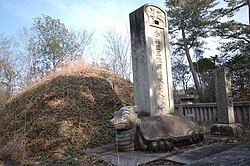Ikeda Terumasa
Ikeda Terumasa (池田 輝政 født 31. januar 1565 i Kijosu i Japan, død 16. mars 1613 i Himejiborgen) var en japansk daimyo tidlig i Edo-perioden.[1] Tittelen hans var Musashi no Kami.
| Ikeda Terumasa | |||
|---|---|---|---|
 | |||
| Født | 31. jan. 1565 Kiyosu | ||
| Død | 16. mars 1613 Himejiborgen | ||
| Beskjeftigelse | Samurai | ||
| Embete |
| ||
| Ektefelle | Toku Hime (1595–) Nakagawa Itohime | ||
| Far | Ikeda Tsuneoki | ||
| Mor | Zen'ōin | ||
| Søsken | Ikeda Sen Ikeda Motosuke Ikeda Nagayoshi Ikeda Nagamasa Waka-mandokoro | ||
| Barn | 10 oppføringer
Ikeda Tadakatsu
Ikeda Toshitaka Ikeda Tadatsugu Ikeda Teruzumi Ikeda Masatsuna Takakatsu-in Ikeda Teruoki Ikeda Masatora Ikeda Toshimasa Ikeda Chachahime | ||
| Nasjonalitet | Japan | ||
| Gravlagt | Kokusei Temple Ikeda clan's Waidani Graveyard Myōshin-ji (–1666) | ||
Han var svoger av daimyo Tokugawa Ieyasu, og da Ieyasu kom til makten i 1598 sørget han for å innsette Terumasa som guvernør for de vestlige provinsene.[1]
Terumasa kjempet mange slag sent i Azuchi-Momoyama-perioden, og fikk for sin innsats i slaget ved Sekigahara et len i Himeji-domenet, som i dag er en del av Hyōgo-prefekturet.[trenger referanse] Terumasa fikk også Himeji-borgen i gave for å ha gitt støtte til Ieyasu Tokugawa under krigen mot daimyoene fra Sekigahara.[2]
Terumasa bestemte seg for å reise et nytt palass i byen Himeji.[1] Det fantes et palass i byen fra før; det hadde blitt reist av Akamatsu Sadanori, og stod ferdig i 1346.[1] Sadanoris slott var ikke grandiost nok for Terumasa, som ville bygge like storslått som borgen til Oda Nobunaga i Azuchi.[1] Byggingen begynte i 1601, og etter at bygningsarbeiderne hadde nedlagt 2,5 millioner dagsverk i å realisere Terumasas planer, stod det nye Himeji-palasset ferdig i 1609.[1] I 1609 kunngjorde Terumasa at Himeji skulle være hans nye hovedstad. Da hadde han et palass som stod i forhold til byens nye betydning og status.[1]

Referanser
rediger- ^ a b c d e f g «AD Classics: Himeji Castle / Ikeda Terumasa». ArchDaily (på engelsk). 30. mai 2017. Besøkt 27. april 2021. «Under Nobunaga and Hideyoshi’s reigns, Japan entered its Azuchi-Momoyama period, named for two castles built respectively by the two leaders. It was a time of sumptuously gilded wall paintings, elaborate folding screens, and the rise of the Japanese tea ceremony. The spread of castles across the Japanese archipelago between 1580 and 1630 remains one of the most prominent remnants of this cultural epoch, with many of the cities that formed around evolving into provincial capitals. When Hideyoshi died in 1598, rule over Japan passed not to his son, but to rival daimyo Tokugawa Ieyasu, who subsequently appointed his brother-in-law Ikeda Terumasa as governor of the western provinces. It was in 1609, at the height of the Azuchi-Momoyama period, that Terumasa chose Himeji as his seat of power – and set about creating a castle worthy of the city’s newfound status.»
- ^ «Himeji : History». www.columbia.edu. Besøkt 27. april 2021. «In 1601, Ikeda Terumasa (1564-1613) was handed control of Himeji Castle as a gift for his support of Ieyasu Tokugawa in the Sekigahara battle against the Toyotomi Daimyo. He intended to model the castle after the emperor's own castle at Azuchi. He undertook a nine year construction program, at the end of which Himeji Castle assumed its present day form. The area which Terumasa ruled over, the districts of Harima, Bizen, and Awaji, was filled with sympathizers of the Toyotomi clan. Thus Himeji Castle played a crucial role in enabling Terumasa to assert his rule over the districts. Some historians believe over 25,000,000 man days were spent on the construction of the castle, which included a five-storied tenshu and a middle and outer moat. Materials from Hideyoshi's old fortress were used in the construction of the castle which was ironically used to prevent Hideyoshi's son from communicating with the lords in the west. Several families took control of the castle after Terumasa, including the Honda, Okudaira, Matsudaira, Sakakibara, and Sakai.»